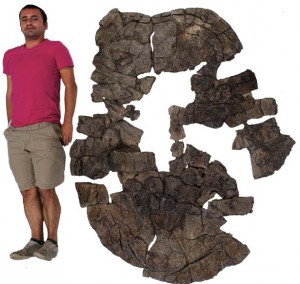So You Found a Giant Turtle…
Edwin Cadena is a doctoral student at NC State, a member of the team of paleontologists who discovered the recently named Carbonemys carbonii, a giant freshwater turtle that lived in what is now Colombia 60 million years ago. I asked if he would answer a few questions about the find’s larger implications, and he graciously agreed.

1. People love finding out about all the cool stuff that roamed the earth before humans came along, but how is the find relevant to humans today?
“In my opinion, the impact that these kinds of discoveries like Titanoboa (the largest snake fossil discovered to date), and Carbonemys have is that they amaze us with how diverse life has been through time, and serve as teaching tools about the value of conservation of existing species – in this case for side-necked turtles. The modern-day side-necked turtles (which are part of the same group as Carbonemys) are threatened, but the fossil record shows us that they have lived in Colombia for more than 60 million years. Also, these giant reptiles show us how creatures that we thought only lived in our imaginations or in movies really existed, and that is fascinating. And if that fascination opens people up to science and discovery, that’s a good impact, especially for kids.”
2. What impact does this turtle have on the field of paleontology? Are you filling in some important blanks? What new questions do you have as a result of this discovery?
“Before the Cerrejon fossils, we didn’t know anything about what kind of animals and plants lived in the tropics of South America just after the extinction of dinosaurs. Cerrejon fossils fill that gap, and also have important implications for understanding the evolution of tropical reptiles. These fossils may also help us determine whether the current species of side-necked turtles are the descents of turtles that lived 60 million years ago. Cerrejonemys, the other turtle described from Cerrejon in 2010, is very close to the pleurodires or side-necked turtles that live in Amazon and Orinoco rivers today.
“In the case of Carbonemys, it is a good candidate to be the ancestor of Stupendemys geographicus (the largest freshwater turtle so far known) which lived in tropical South America around 7 million years ago. If so, this indicates that large size in this group of turtles was reached for the first time 60 million years ago, and that it probably persisted until the extinction of Stupendemys in the last 5 million years.
“We still have a gap that corresponds to the time between Carbonemys (60 million years ago) and Stupendemys (7 million years ago), and it is interesting because during that time the Earth experienced a series of global warmings and ice-house events, so a big question is if the size of the Carbonemys descendants varied with these climatic events. This information has implications for our current models that predict species extinction based upon the sensitivity of tropical reptiles to climate change. The fossil record is one of the best tools that we have for validating ecological and biological models and rules.”
3. What are the next steps with this research? What is the end goal?
“There is nothing more exciting for me than being able to discover creatures that the world never imagined could have existed, so I’ll continue doing it. In particular, I am planning to return to the Cerrejon coal mine soon, because it is probable that there are bigger turtles than Carbonemys, as well as other undiscovered reptiles there, waiting for us. I am working on other fossil turtles from tropical South America, fascinating extinct creatures that I should be able to talk about more fully in the next couple of years.
“The main goal of this research is to reveal to the world the origin and evolution of tropical biodiversity — in my case, for turtles.”


